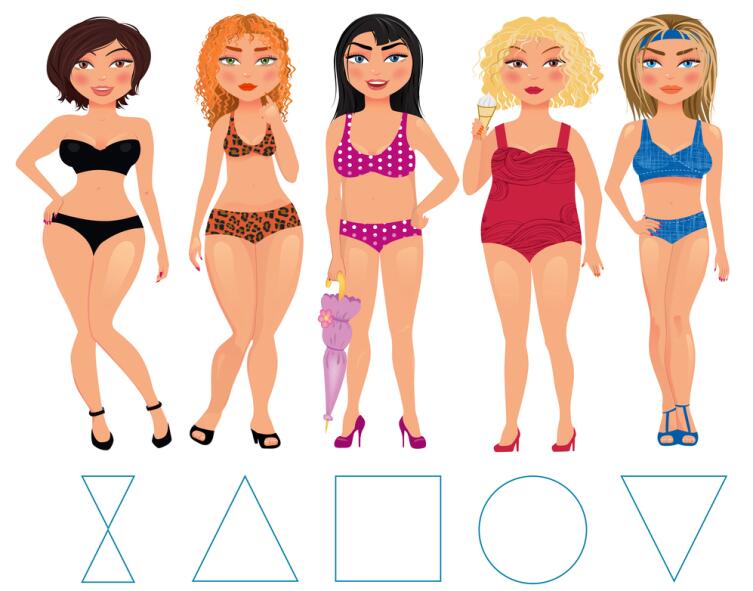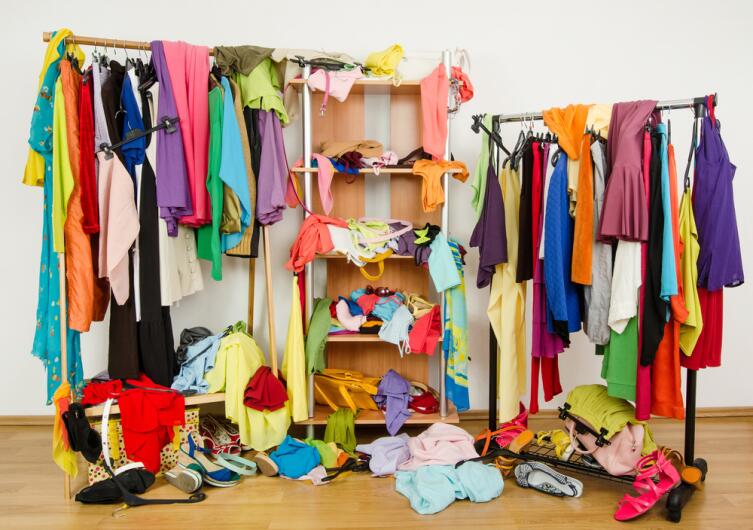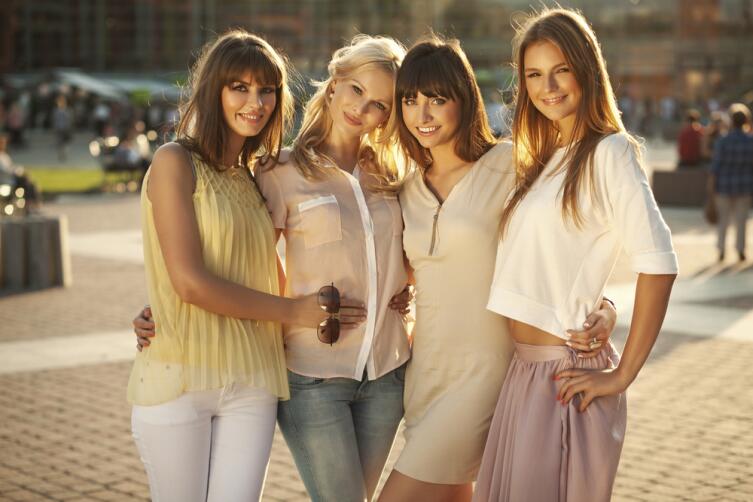What is shopping useful for?
Nothing to wear Seven easy steps to a perfect wardrobe
There is not enough space in your closet for new things, but are there really few really successful sets? This is a typical situation with irrational wardrobe.
 In the opposite case, when the wardrobe is carefully thought out - you get by with a minimum of things that form a huge number of harmonious sets that are ideal for you in shape, color type and corresponding to your lifestyle and tasks. This is not so difficult to achieve, armed with enthusiasm, and ... our step-by-step guide! 1. Define your type of figure to understand which styles will correct it and sit on you in the best way. Use only the styles recommended for your type of figure during the subsequent analysis of the wardrobe and shopping.
In the opposite case, when the wardrobe is carefully thought out - you get by with a minimum of things that form a huge number of harmonious sets that are ideal for you in shape, color type and corresponding to your lifestyle and tasks. This is not so difficult to achieve, armed with enthusiasm, and ... our step-by-step guide! 1. Define your type of figure to understand which styles will correct it and sit on you in the best way. Use only the styles recommended for your type of figure during the subsequent analysis of the wardrobe and shopping. 2. Determine how contrasting your appearance is . If the hair or eyes are very dark, and the skin is very light, or, conversely, the hair is a bright blond, but the eyes are dark and the skin is very dark, then the appearance is contrasted. Your clothes should not be more contrasting than your appearance, otherwise you simply “get lost” in this outfit and look like a gray mouse on its background ... Note that we are not talking about color types in this paragraph: firstly , you need to worry about color only if this color is on the face (blouses, tops, cardigans, dresses, outerwear, hats, scarves); secondly , even if the color does not suit you, there is a way out in the form of accessories: in many cases, a scarf, necklace, scarf can “save” the situation from the unsuccessful color.
2. Determine how contrasting your appearance is . If the hair or eyes are very dark, and the skin is very light, or, conversely, the hair is a bright blond, but the eyes are dark and the skin is very dark, then the appearance is contrasted. Your clothes should not be more contrasting than your appearance, otherwise you simply “get lost” in this outfit and look like a gray mouse on its background ... Note that we are not talking about color types in this paragraph: firstly , you need to worry about color only if this color is on the face (blouses, tops, cardigans, dresses, outerwear, hats, scarves); secondly , even if the color does not suit you, there is a way out in the form of accessories: in many cases, a scarf, necklace, scarf can “save” the situation from the unsuccessful color.
3. Analyze your lifestyle to clearly understand what goals a wardrobe should serve. For example, 65% of the time you spend at work, 10% at home, 15% at a fitness club, and the remaining 10% takes leisure time. In this case, your wardrobe should have 65% of things for work, 10% for home, 15% for sports, 10% for leisure. But such a distribution does not fit the young mother on maternity leave; it will not suit you if you are a freelancer and work from home; therefore, spend 5 minutes of time for analysis and further work with the wardrobe.
4. Choose your preferred style. Perhaps you want to look softer and more feminine? In this case, pay attention to the romantic style. Or maybe you, on the contrary, lack rigor, elegance and conciseness? Look for the right notes in a business style. If you want more dynamics, courage, pressure and enthusiasm in your everyday looks - turn to the style of “sport chic”. If you are a writer in the fantasy genre and you want your image to be in harmony with your works, a dramatic style will suit you. And if you are a designer or artist and want your image to convey your creative thinking, mobility and freedom, but at the same time be somewhat businesslike and strict, you will probably like the eclectic style of “smart casual”. Remember: it is not necessary to adjust your entire wardrobe to one clear clothing style ; just add certain elements to create the appropriate images.
5. Disassemble the wardrobe. The list of things that you need to get rid of in order to finally get rid of the " nothing to wear " problem : Well-worn things that have lost their appearance. Do not leave them for home! At home, you also need to look well-groomed. Things that do not sit well on you: gain weight, visually shorten your legs or make your figure disproportionate; have an unsuccessful cut or material, give out surprises (the thing is prickly or when worn, ugly folds form that spoil the look; things that tend to stretch to form ugly “bubbles”). Unsuitable clothing. Things that you for some reason have not worn for several years and, most likely, will not be worn in the coming years. Things that require specific care that you are not ready for (dry clean, steam at the studio, alter, etc. ). Things that cause discomfort while wearing: those that crush or, on the contrary, fly off; uncomfortable to wear things that slide down or rise up, collect a lot of dust and villi, become electrified, shine through.
 I would like to note that for independent analysis of the wardrobe it is not at all necessary to possess the knowledge of a professional stylist: you yourself are able to understand whether a certain thing adorns you or, conversely, spoils it. Just be careful and objective: You may really like some thing, but because of the peculiarities of the figure, it sits on you unsuccessfully, and it is better to part with it. You may be madly in love with a certain color, but it doesn’t suit you personally: your face becomes too pale or acquires a yellowish unhealthy shade, blushes, turns pale, darkens ... How to deal with this thing depends on you: you can get rid of it, but you can leave it and wear it with certain accessories to eliminate the so-called “side effect” from the wrong color. By the way, the notorious theory of color types causes more and more debate. The fact is that everything is not so clear here ;: for example, your skin and hair can be warm in color, and your eyes can be cold, and vice versa. Therefore, it’s sometimes easier to take a thing, put it on the face in daylight and determine how it affects the appearance - how the color of the face, eyes and hair changes: if the face looks fresher, the eyes are brighter, and the contrast print does not lead the person to the background ( you are visible first of all, not the dress) - everything is in order, the thing is suitable.
I would like to note that for independent analysis of the wardrobe it is not at all necessary to possess the knowledge of a professional stylist: you yourself are able to understand whether a certain thing adorns you or, conversely, spoils it. Just be careful and objective: You may really like some thing, but because of the peculiarities of the figure, it sits on you unsuccessfully, and it is better to part with it. You may be madly in love with a certain color, but it doesn’t suit you personally: your face becomes too pale or acquires a yellowish unhealthy shade, blushes, turns pale, darkens ... How to deal with this thing depends on you: you can get rid of it, but you can leave it and wear it with certain accessories to eliminate the so-called “side effect” from the wrong color. By the way, the notorious theory of color types causes more and more debate. The fact is that everything is not so clear here ;: for example, your skin and hair can be warm in color, and your eyes can be cold, and vice versa. Therefore, it’s sometimes easier to take a thing, put it on the face in daylight and determine how it affects the appearance - how the color of the face, eyes and hair changes: if the face looks fresher, the eyes are brighter, and the contrast print does not lead the person to the background ( you are visible first of all, not the dress) - everything is in order, the thing is suitable.
Unnecessary things can be donated to a charity, sold inexpensively on Avito or Yulia, can be taken to an H&M store (they accept things in any condition and, depending on it, are distributed either for processing to receive furniture filler fiber or for charity purposes).
6. Make a list of things that you need to purchase in order to get the maximum number of sets in combination with your existing items, in accordance with your external data and daily tasks. For example, an item from your list might look like this:
“Buy: a dress for a dark green jacket (so that you can wear it with a jacket, vest, cardigan, coat). Style: semi-fitted sheath dress with a v-neck (according to the type of figure). Color - blue / brown / gray / wine red (suitable for all other clothes and shoes). The fabric is dense, tough (to keep in shape), wrinkled (so that there are no wrinkles after a working day at the computer in the office or in the evening at the theater, and that it is convenient to take along for business trips). ”
To choose clothes that will be in harmony in color with those things that you already have, you can use Itten’s color wheel (it’s not at all necessary to buy it in an artist’s store or print and make it yourself, you can simply use online services, for example, colorscheme. ru) Keep in mind that most of the wardrobe should be basic things that serve as the basis for most kits. They can be both monophonic and printed; both neutral and bright (it all depends on your tasks, style and most of the others that are already in your wardrobe). And accents are accessories; choose them carefully: they should fit most of your sets, emphasize the advantages of your appearance (bright eyes, thin beautiful fingers, graceful wrists) and correct imperfections (visually lengthen the face, neck, body or, vice versa - add volume). There is a rule according to which accessories should be more expensive than clothes (even if we are talking about jewelry), since they serve as accents, attract the main attention and often create a general defining impression of your image.
7. Go shopping! Follow the compiled list and never buy a thing just because you liked it, or because it is now on sale. On the contrary, do not rush to reject the thing, the price of which, in your opinion, is too high: because if the thing is basic, made with high quality and from good materials, it will be used in the wardrobe an unlimited number of times. The real value of a thing is equal to the number of times you used it divided by the actual value of the thing. If you learn this principle, you will understand that sometimes the expensive cashmere sweater from the new collection, worn 100 times, actually turns out to be cheaper than the dress you bought on sale, which you wear twice in your life. Understanding this principle will save you time and money. After your ideal wardrobe is formed - remember or take pictures of all the sets so that neither in a hurry, nor in new circumstances, or at an unexpected invitation to the theater ... in general, NO-KOG-YES will no longer ask what to wear today. And just enjoy life and rationally use the time that was previously spent on useless shopping and endless selection of clothes !

